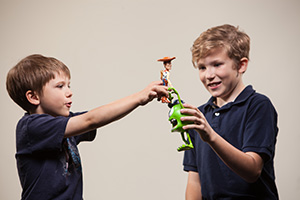Couple joins forces to reveal Pixar’s hidden messages
INT. PIXAR FILM
Cast of Characters:
Large, masculine, athletic hero
Various others who admire the hero
On the one hand, the Pixar films are quite progressive and portray men as warm and fatherly, but they often vacillate between this family-man persona and a hyper-masculine male representing a “boys don’t cry” attitude.

“The project started in the car,” said Wooden. “We were on a road trip and listening to “Cars” on the DVD player for the nine hundredth time. We started talking about the way the characters treated each other and the way the film represented winners and losers.”
Having two little boys has given Wooden and Gillam great opportunities to examine the messages in the films, as well as their children’s immediate reactions to it. One example Gillam noted is one of Pixar’s more recent films, “Monsters University,” which shows Mike Wazowski getting bullied for his small stature throughout the film. Eventually, Wazowski learns to accept his role in society rather than fight against predetermined stereotypes.
“What kind of message is that to send to kids?” asked Wooden. “If you have the misfortune to not be born in the right kind of male body, you may as well get used to life as a loser. Try to learn to be happy in your second place — or lower — status, because your options here are find complacency in your ‘lesser than’ status or get really angry, like the lemons did in “Cars 2,” and become punished for an alternative, oppositional form of masculinity.”
Lack of big muscles and broad shoulders isn’t the only thing that Pixar views negatively. Creativity and inventiveness aren’t always a positive trait when it comes to the films, and they are often associated with villainous behavior.
“Take Sid Phillips in “Toy Story” and “Toy Story 3” — he’s a rambunctious, but probably really bright, kid and he’s not doing anything wrong per se,” said Gillam. “He’s taking toys apart and things like that, but the very concept of the movie is that human beings don’t know toys have a kind of life outside being an inanimate object. So in taking heads off and blowing stuff up, Sid is just a kid playing rough.”
EXT. PIXAR FILM
Cast of Characters:
You
Various other movie goers
Wooden and Gillam see numerous opportunities in the films to break these negative stereotypes. Pixar is a powerhouse for establishing social norms, and if applied in a positive manner, these stereotypes could easily be changed or even dismissed entirely, they noted.
“They’ve got incredible influence over establishing, affirming and maintaining cultural norms for kids,” said Wooden. “They’re not the only ones obviously — all society contributes to establishing how kids see the world — but they are a big, powerful, ideological force. Besides, it’s animation. There’s opportunity and potential to rewrite some of these scripts. They don’t have to make Sid the hero of the film, but they could make Sid anything.”

Gillam and Wooden’s first book, “Pixar’s Boy Stories: Masculinity in a Postmodern Age,” was released in April 2014. The book details their research into Pixar’s portrayals of masculinity over the years, and they hope that it calls attention to an often overlooked issue in today’s society.
“Somebody had to be the first person to complain about the Disney princesses’ stifling representation of women, right?” said Wooden. “A parallel conversation for boys hasn’t started, but we’re trying to start it…so people become aware of what they are watching and what their kids are watching.”


Didn’t Mike become the hero of that story by becoming exceptionally good at scaring and was the head of the class? Was accepting his “place” bad if he showed that even if he couldn’t fight or intimidate the bullies that he could out work them and surpass their abilities? Doesn’t Andy’s imagination and creativity become one of the most celebrated and iconic in Disney history? Didn’t Cars 2 make its hero the rusty, banged-up, old tow truck rather than the famous race car from the first movie? You can’t say Pixar discourages creativity, forces the thought of masculinity being required for success, or that you are given your lot in life because of how you are built. Remember that film Pixar made about the little boy born with a birth defect but was then taught by people he didn’t even know that he was perfectly able and that he was not helpless? A little boy by the name of Nemo. Pixar does nothing like what you are saying to set norms they way you are saying. They didn’t make Sid a villain, they made him destructive force. Cars 2 didn’t lemons evil, it made manipulative oil tycoons evil. Monster University didn’t repress a person because of their size, they made an underdog surpass all expectations and become one of the best students on campus. Saying Pixar is deliberately teaching kids that creativity, scholarship, and pride in one’s own body no matter how “masculine” (Nemo, Mater, etc.) they are is bad, is saying that the lessons one can learn who isn’t fitting Your views of masculinity are lessons that are better off not being learned.
I must agree with Mr. Tellin. While it is true that Pixar and other movie companies are instrumental in shaping cultural norms through the messages they send, I must dissent from these two professors concerning their interpretation of the messages being sent.
Pixar movies routinely reject the idea that men must be burly and broad-shouldered, as evidenced by the fact that those men are often the villains or bullies in the movie. Those watching the movie then naturally identify with the protagonist and find fault with those that are stronger.
It’s the classic tale that we’ve seen since for centuries. In The Once and Future King about King Arthur, we see Arthur reject the notion that “might makes right” as society had previously established. Instead, compassion, wisdom, and justice must take the forefront. Mike Wazowski does not learn to accept his role and to cease fighting predetermined stereotypes – he learns that he is entirely capable of achieving his dreams, especially when you consider Monsters Inc., in which at the end he is the one who takes center stage when they determine that laughter is much more productive than screams. He not only fights stereotypes, he alters the entire basis of their society.
I do want to note that I agree that Sid is portrayed as a villain while, in reality, he’s just a kid who is destroying pieces of plastic. However, to make the leap that the movie is therefore against creativity is a misrepresentation of the message meant to be sent. Instead, the basic message of Toy Story was to love and care for others, as Andy did, instead of being destructive.
I believe one could yield the same kind of response that Dr. Wooden and Dr. Gillam have come to by looking at the initial, surface figures presented in the Pixar movies. However, I find a great deal of fault in their overall logic behind the representation of hyper masculinity as the focal point within the movies. Even more so with the belief of a “boys don’t cry” mindset.
In Planes, the hero is someone not of perfect build, style, or design. The movie clearly represents the hyper masculine role as being mean, deceptive, rude, and manipulative. The ‘loser plane’, as associated with this article’s claim, shows perseverance in the challenges of adversity, about overcoming obstacles, about having more worth and heart than the bullying plane. The movie even goes so far as to show how all of the super masculine figures are brutish, belligerent, and degrading.
In Toy Story, you have two primary male characters represented in the toys, Woody and Buzz. Buzz may take on the role of the hyper masculine, but Woody does not. Woody is represented as tall, gangly, not very graceful, fumbles in his actions, makes rash decisions, shows signs of emotion and jealousy. Buzz, however, is first depicted as the same brash and belligerent type of character. It’s only after he falls from a window (fall from grace?), plummets down a staircase, has his arm replaced by the very toys that represent the masses of ‘non-perfect society’, that he starts to change into a well-meaning character. The movie explores how the hyper masculine role doesn’t really fit, but rather needs to find humility and acceptance within the world before he truly ‘comes of age’.
In Toy Story, Sid isn’t a reluctant hero or a misrepresented hero. Pixar represents the destructive nature of Sid as a means to portray how greed, destruction, a lack of care of other and for other’s things (taking his sister’s doll to deliberately rip off the head to replace it with something different in a defiant and cruel manner), are not traits that one should embrace. Pixar also uses Sid to explore how a lack of care for preservation, a perversion of norms, a belligerent disregard for authority and rules, torture and manipulation are all traits are characteristics that people should stand up to and not accept. Pixar isn’t saying that Sid is the misguided and excluded individual from societal norms, thus being pushed around by the hyper masculine. Nor is Pixar outlining a repressive case for individuality, creativity, or inventiveness. Sid is the representation of things wrong in society that require attention and merit change. Not a stifling case of ‘stay in the box’.
Cars, the hyper masculine McQueen goes through the same trials as Buzz in Toy Story. It shows how arrogance in the overly masculine represented car leads to his own downfall. It shows how his belief that he was right and the town of Radiator Springs was wrong, until he was humbled by the very cars he believed were not his equal. An ‘old man’ and an ‘uneducated, socially awkward, ill dressed (Mater)’ teach the hyper masculine figure about life in such a way that McQueen changes into a character that we actually like. Power, in this sense, lies not within the hyper masculine, but in the non-hyper masculine.
The point is there are few times in any of these movies where the text, sub-text, or subversive meanings reflect how the hyper masculine figure is the predominant force in the movie, or the idealized role model for the viewers. If ever there is a hyper masculine figure taking center stage, the movie always goes out of its way to bring the masculine character through trials and tribulations in which they learn that the hyper is not the way to be. In like fashion, every Pixar movie denotes how the hyper masculine figure always bears initial characteristics of cheating, lying, bullying, propagating hateful remarks to those around them, lacks compassion, lacks humility, and lacks all things quintessential to decent societal acceptance. It is always the non-hyper masculine character(s) that become the force for change, progression, and stability.
If the Pixar movies do nothing else but one thing, they show how not being part of the hyper masculine group is a good and welcomed thing. They show how to overcome adversity (the world), how to use ones individual traits for good, how being different can change those around them, how finding confidence within themselves instead of trying to fit a pre-constructed image gives you happiness and peace, how believing in the merits of your own worth outweigh the conditions created by the few in the masculine. The Pixar movies do anything but promote the hyper masculine image as the image of choice. They do, however, emphasize how individuality and believing in yourself will take you to ‘infinity and beyond’.